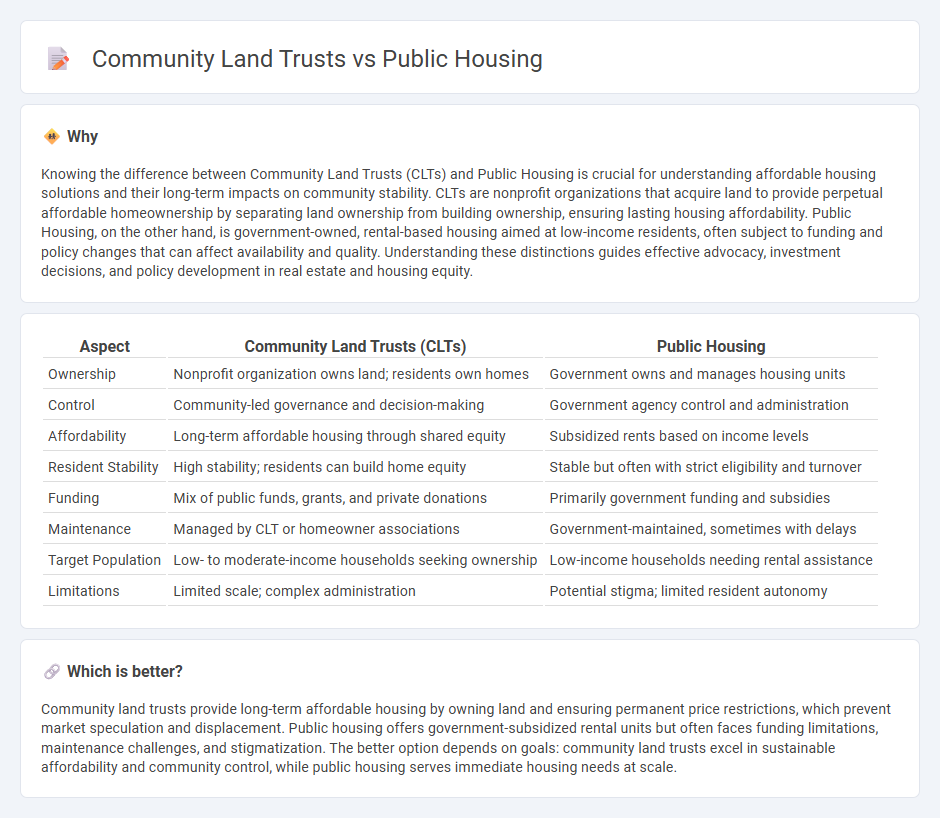
Community land trusts empower residents by providing long-term affordable housing through nonprofit ownership of land, ensuring stability and local control. Public housing, managed by government agencies, offers subsidized rental units aimed at low-income families but often faces challenges like limited funding and maintenance issues. Discover how these models address housing affordability and community development by exploring their key differences and benefits.
Why it is important
Knowing the difference between Community Land Trusts (CLTs) and Public Housing is crucial for understanding affordable housing solutions and their long-term impacts on community stability. CLTs are nonprofit organizations that acquire land to provide perpetual affordable homeownership by separating land ownership from building ownership, ensuring lasting housing affordability. Public Housing, on the other hand, is government-owned, rental-based housing aimed at low-income residents, often subject to funding and policy changes that can affect availability and quality. Understanding these distinctions guides effective advocacy, investment decisions, and policy development in real estate and housing equity.
Comparison Table
| Aspect | Community Land Trusts (CLTs) | Public Housing |
|---|---|---|
| Ownership | Nonprofit organization owns land; residents own homes | Government owns and manages housing units |
| Control | Community-led governance and decision-making | Government agency control and administration |
| Affordability | Long-term affordable housing through shared equity | Subsidized rents based on income levels |
| Resident Stability | High stability; residents can build home equity | Stable but often with strict eligibility and turnover |
| Funding | Mix of public funds, grants, and private donations | Primarily government funding and subsidies |
| Maintenance | Managed by CLT or homeowner associations | Government-maintained, sometimes with delays |
| Target Population | Low- to moderate-income households seeking ownership | Low-income households needing rental assistance |
| Limitations | Limited scale; complex administration | Potential stigma; limited resident autonomy |
Which is better?
Community land trusts provide long-term affordable housing by owning land and ensuring permanent price restrictions, which prevent market speculation and displacement. Public housing offers government-subsidized rental units but often faces funding limitations, maintenance challenges, and stigmatization. The better option depends on goals: community land trusts excel in sustainable affordability and community control, while public housing serves immediate housing needs at scale.
Connection
Community land trusts and public housing both aim to provide affordable housing solutions by maintaining long-term property affordability and preventing market-driven displacement. Community land trusts achieve this by owning land collectively and leasing it to residents, ensuring permanent affordability, while public housing is government-owned and subsidized to offer low-cost rental units. Both models address housing insecurity through nonprofit or public sector involvement, promoting stable, inclusive communities.
Key Terms
Subsidized Rent
Subsidized rent models in public housing typically involve government-owned properties where rent is set below market rates based on income eligibility, ensuring affordability for low-income families. Community land trusts (CLTs) separate land ownership from housing, enabling residents to lease land at minimal cost while maintaining ownership of their homes, which stabilizes long-term subsidized rent and prevents market-driven displacement. Explore how these approaches uniquely impact affordable housing sustainability and community empowerment.
Collective Ownership
Public housing is typically owned and managed by government agencies, providing affordable housing through direct ownership, while community land trusts (CLTs) are nonprofit organizations that acquire land to ensure long-term affordability through collective ownership by residents. CLTs separate land ownership from housing ownership, allowing residents to purchase homes while the trust retains land control, promoting community stewardship and preventing displacement. Discover how collective ownership models like CLTs can transform affordable housing by fostering stability and empowerment.
Affordability
Public housing offers government-subsidized rental units designed to provide immediate affordability for low-income families, often managed by local housing authorities to maintain long-term affordability. Community land trusts (CLTs) focus on permanently reducing housing costs by owning land and leasing it to homeowners at below-market rates, preserving affordability across generations through community ownership models. Explore how these two strategies address housing affordability challenges and their impact on sustainable community development.
Source and External Links
Public Housing Program | HUD.gov / U.S. Department of Housing - Public housing provides decent and safe rental housing for eligible low-income families, the elderly, and persons with disabilities, managed locally and federally supported by HUD to ensure affordability and proper administration.
Public housing - Wikipedia - Public housing, also known as social housing, is subsidized housing owned and managed by government or nonprofits, aimed at reducing housing inequality and is typically allocated based on income and need.
Public housing | USAGov - Public housing offers affordable rental homes to low-income individuals, seniors, and people with disabilities, with eligibility and application managed by local public housing agencies.
 dowidth.com
dowidth.com